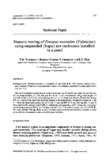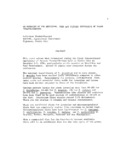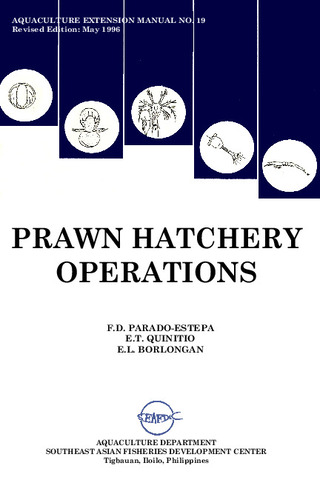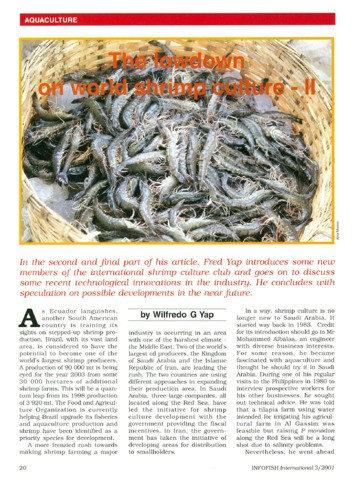Nursery rearing of Penaeus monodon (Fabricius) using suspended (hapa) net enclosures installed in a pond
Share
Abstract
The use of suspended (hapa) nets as nursery enclosures for shrimp fry was tested. In the first trial, four stocking densities (72, 144, 288, and 432 fry m−3) of P. monodon fry (PL20, body weight = 8 mg, body length = 12.6 mm) were evaluated in 1×1×1.5 m hapa nets. Results showed that shrimp BW, BL, and survival rates were inversely related to stocking density. Shrimp fry stocked at 72 fry m−3 attained significantly greater BL of 22 and 37 mm and BW of 50 and 260 mg after 15 and 30 days, respectively, and survival of 92%. A verification trial using PL28 (BW = 10 mg, BL = 13.2 mm) at a stocking density of 288 fry m−3 in hapa nets of 2×3×1.5 m yielded a mean survival of 97%, BL 48.1 mm, and BW 780 mg. Hapa nets are therefore useful as alternative shrimp fry nursery systems in the absence of specialized tanks or pond nursery facilities.
Suggested Citation
Rodriguez, E. M., Bombeo-Tuburan, I., Fukumoto, S., & Ticar, R. B. (1993). Nursery rearing of Penaeus monodon (Fabricius) using suspended (hapa) net enclosures installed in a pond. Aquaculture , 112(1), 107-111. https://doi.org/10.1016/0044-8486(93)90162-R
Subject
Taxonomic term
Collections
- AQD Journal Articles [1248]
Related items
Showing items related by title, author, creator and subject.
-
An overview of the nutrition, feed and feeding techniques of prawn penaeid/shrimps
Piedad-Pascual, Felicitas (Philippine Council for Aquatic and Marine Research and Development, 1989)This paper echoes what transpired during the first International Conference of Penaeid Prawns/Shrimps held in Iloilo City in December 4-7, 1984, particularly on the Nutrition nd Feed Development. Around 25 papers were ... -
Prawn hatchery operations
Parado-Estepa, Fe D.; Quinitio, Emilia T.; Borlongan, Emeterio L. (Aquaculture Department, Southeast Asian Fisheries Development Center, 1996-05)The manual, an updated version of the 1984 SEAFDEC/AQD manual, presents the underlying principles and step-by-step instructions of prawn larval and post-larval rearing. The techniques described are not only applicable to ... -
The lowdown on world shrimp culture - II
Yap, Wilfredo G. (INFOFISH, 2001)This paper introduces some new members of the international shrimp culture club and goes on to discuss some recent technological innovations in the industry, particularly the polyculture of tilapia (mainly Oreochromis ...




